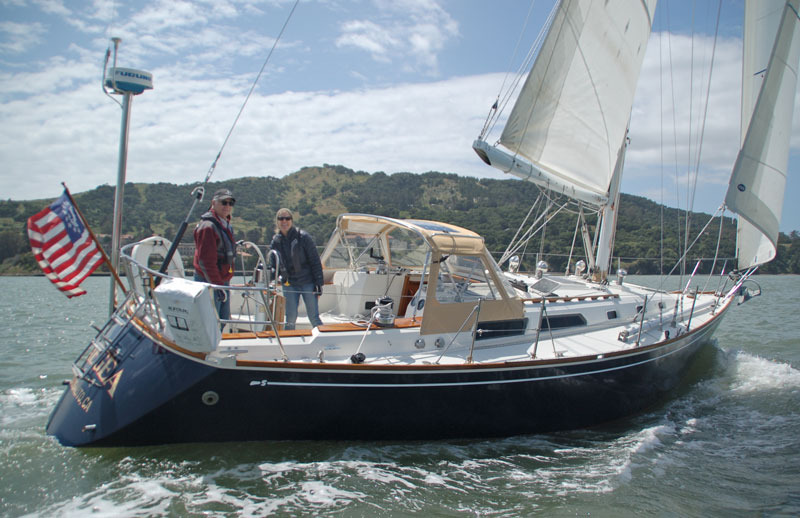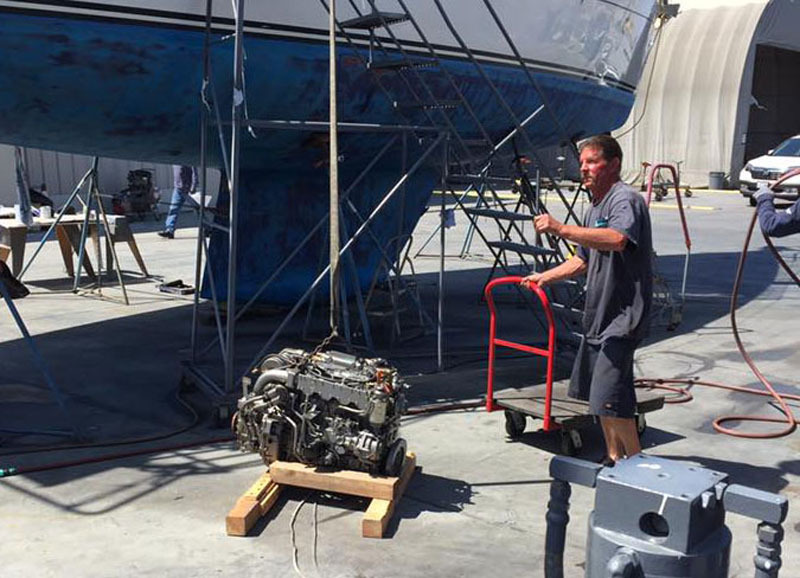
Lookin’ Good on a Sabre

©Latitude 38 Media, LLC
We recently caught Randy and Jennifer Gridley out on their new-to-them Sabre 38 MkII Aegea. Turns out Randy, a college classmate of our new publisher, and Jennifer, who happened to be brought up in the same small town back East, heard that Latitude 38 had changed hands in November and thought they’d pick up a copy.
As always, they looked through the Classy Classifieds to see what was there and spotted this sweet sloop for sale. Randy ‘popped the question’ — "What do you think?" Jennifer replied, "Let’s go for it." Next thing you know they’re the owners of a Sabre 38 and are out lookin’ good on San Francisco Bay.
High Five from the Invisible Hand
This past weekend, Newport Harbor Yacht Club hosted its first annual One Design Offshore Championship in idyllic sailing conditions. The fleets consisted of the recently activated four-boat Pac 52 fleet and the always-competitive Southern California J/120 fleet.
The Pac 52s were topped by Northern Californian Frank Slootman with his new steed Invisible Hand, while the J/120 fleet found Chuck Nichols on top with CC Rider.

The high-tech, all-carbon Pac 52s were created to provide level racing for both inshore and offshore events, and Slootman is putting Invisible Hand to the test. The boat recently took line honors in the SoCal 300, will next compete in Long Beach Race Week, and then sail the Transpac before returning to buoy racing for the Big Boat Series in the fall. It’s a full schedule testing the Pac 52’s full range of capabilities.
See the complete results of the NHYC One Design Championship here.
How Many Hours on Your Diesel?

©2017Latitude 38 Media, LLC
Marine diesel mechanics have told us that most marine diesels go bad after about 4,000 hours. This is a shame, because marine diesels should be good for anywhere from 10,000 to 14,000 hours. And even more.
Usually the reason they go bad is lack of use, or misuse. Diesels are designed and built to be used often — nonstop isn’t bad — and under a big load. This is rarely how most recreational sailboat diesels are used.
In most cases sailboat diesels are used infrequently, and when they are used, it’s often only for short periods of time, and often at idle or near-idle speeds. This is the worst way in which a diesel can be used. And it’s the rare sailboat owner who warms up his diesel before putting it under load, or lets it cool down after hours of being under load.
Despite misuse, some diesels just go on and on and on and on. The 76-hp Yanmar diesel on Steve Schmidt’s SC70 Hotel California, Too has been badly abused in the sense that it’s almost never been used for propulsion in something like 30 years, but only to charge the batteries and power the refrigeration. That kind of misuse is often the death knell for a marine diesel, but Schmidt’s has well over 17,000 hours. Perhaps the boat’s saving grace is that Schmidt uses the boat — and diesel — something like nine months a year.
We have two Yanmar 56-hp diesels on ’ti Profligate in the Caribbean, and they spent nearly 15 years presumably being ‘abused’ by countless charter guests motoring madly around the British Virgins. But as long as the engines were properly maintained — oil and water levels, as well as belts and general engine condition, checked before each charter — which they were, it wasn’t ‘abuse’ at all. It was the frequent hard use that diesels thrive on.
As a result, both our 17-year-old Yanmar diesels have over 10,000 hours. But they run great, and burn almost no oil at all. In fact, they burn less oil than do the same diesels on Profligate, which have half the hours and don’t get as much use each year.
The engine-hour question came up after Jim Fair of the Berkeley-based Outbound 46 Chesapeake, which Jim and Linda Powers just spent nine years sailing around the world, reported he removed his Yanmar diesel in San Diego for a rebuild. And after just 3,700 hours.
“It’s been burning about a quart of oil every 24 hours,” reports Jim. “I’m not really sure of the cause, as it could be the seals on the turbocharger or the valve stems pitting on one of the cylinder walls. The rebuild guys will bore out the cylinders and install oversize pistons, along with a lot of other stuff. The engine is getting about as major of a rebuild as you can get, short of replacing the engine.”
Fair thinks the decline of his Yanmar took place over about a four-year period. The sequence of events was: 1) A small loss of coolant in the header tank, which he thinks was really air going into the header tank and forcing coolant to overflow into the overflow tank. 2) An incorrect diagnosis of the radiator cap’s being bad. 3) A leak in the heat exchanger. 4) A leak in the hot water tank. 5) Some oil consumption. 6) A catastrophic leak in the head gasket, at which time it was finally diagnosed correctly as a blown head gasket.
So what’s the story with your marine diesel? Have you been treating her right? Has she been treating you right? How many hours does she have, or did she have before major work needed to be done?
Classy Classified Deadline Tomorrow
"As a result of my Classy Classified in Latitude 38, our boat sold quickly. Thanks for your help in making the placement of the ad easy, and for your great customer support!"

If you want a proven method to sell your boat, get your ad into the July issue of Latitude 38. The deadline is tomorrow, June 15, at 5 p.m. A 40-word ad is just $40, and best of all, you can do it online.
Margaritaville Musical
How does the purveyor of the laid-back lifestyle remain so prolifically productive in such diverse and seemingly disparate activities as hotel development, songwriting, book writing, concert tours, opening restaurants, and even a new senior living development in Florida called ‘Latitude Margaritaville’ that is described as, ". . . that happy place in your mind, the spirit of adventure in your soul." Jimmy does it all while strumming his six-string and endlessly enjoying himself on stage and on the water.
Next winter, Jimmy Buffett will add a Broadway musical to his endless repertoire of creative output when Escape to Margaritaville takes the stage in New York after its recent premiere at the La Jolla Playhouse. A bartender named Tully falls in love with a tourist, the music kicks in, and another Jimmy Buffett tale unfolds.
Meanwhile, the latest vision for living the dream of the sailing and surfing lifestyle profiled in a 2015 ‘Lectronic Latitude is underway at Friendship Yacht Company in Portsmouth, RI, where they are completing construction of Buffett’s new Surfari 44. Complete with rooftop surfboard rack, the boat is scheduled to launch and sail this summer.

©Latitude 38 Media, LLC
If you’re a sailor, it’s hard not to cross tacks and enjoy the Jimmy Buffett vibe somewhere on your voyage. And whether you’re on Broadway or in that ‘one particular harbor’, you’ll likely find Jimmy Buffett there in spirit, playing on someone’s stereo . . . or anchored next door.
